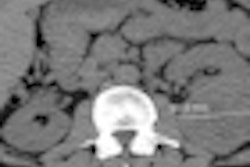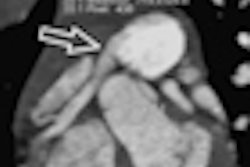
SAN FRANCISCO - Building a comprehensive and successful lung cancer screening program means lining up the considerable resources you'll need in advance, according to a presentation at the International Society for Computed Tomography (ISCT) annual meeting.
In his talk at the symposium, Dr. Jared Christensen, director of radiology for Duke Medicine's 1-year-old CT lung cancer screening program, said creating a solid business plan and planning to provide the resources are two keys to success.
The time for lung cancer screening is now -- or at least within the next few years, experts say. The results of the National Lung Screening Trial (NLST) are in, and they're compelling: a 20% mortality reduction when long-term smokers are screened for lung cancer with CT.
But throughout the U.S., programs to screen large numbers of patients are just getting started. Duke University is among the institutions with a screening program in place, and radiologists there have some advice for anyone else considering the move.
Broad support for screening
Since the publication of NLST results last fall, several medical societies -- including the American Cancer Society, the American College of Radiology, the American College of Chest Physicians, the American Lung Association, the American Society of Clinical Oncology, and the U.S. Preventive Services Task Force -- have signed on to endorse low-dose CT screening for high-risk individuals, Christensen said.
The National Comprehensive Cancer Network (NCCN) gave screening of high-risk individuals its highest recommendation, even higher than breast cancer screening, and provides guidelines for managing individuals with detected lung nodules.
 Dr. Jared Christensen from Duke University School of Medicine.
Dr. Jared Christensen from Duke University School of Medicine.Even a couple of insurers -- including Anthem Blue Cross in California and WellPoint, though not the U.S. Centers for Medicare and Medicaid Services -- have signed on.
"I suspect that as the months continue to pass, additional insurers who look at the data and are constantly evaluating particularly the cost-effectiveness will also jump on board," he said.
Global research and technology firm the Advisory Board polled 104 cancer centers in March and found that 32% have lung cancer screening programs, Christensen said. Among the 68% of centers without programs, 77% plan to begin one within a year.
Duke Medicine joins several other early adopters in CT lung cancer screening, including MD Anderson Cancer Center; the Mayo Clinic in Rochester, MN; University of California, San Francisco Medical Center; Brigham and Women's Hospital; Emory University; and MedStar Georgetown University Hospital, as well as several other major centers.
Building the screening team
"Once you've decided this is something worthwhile, you need to develop your team," Christensen said. "This is primarily a radiology-led initiative; however, radiology cannot do it alone. It requires multidisciplinary collaboration."
In addition to radiology, Duke recruited for its program:
- Pulmonologists
- Thoracic surgeons
- Thoracic oncologists
- Radiation oncologists
- A clinical coordinator
- A research coordinator
- A tobacco coordinator
The tobacco coordinator is an important role, as "it's been noted in several studies looking at initial cost-effectiveness that smoking cessation is an important factor in making low-dose CT screening cost-effective," Christensen said.
The clinical coordinator takes care of communicating results and scheduling. The radiology technical component includes individuals assigned to protocols, which are in Duke's case modeled after NLST. The technical component also includes reporting algorithms and technologists, he said. The individual in charge of scheduling ensures that patients are scheduled appropriately and that insurance is not billed.
Referring physicians are another key component that includes family medicine, internal medicine, and other primary care physicians who need to be very informed about lung cancer screening data, as well as the benefits and potential harms of screening, Christensen said.
On the business side of things, "our business manager was actively involved in negotiating, particularly on the self-pay discount associated with this service, as in North Carolina, screening is not currently covered by our insurers," he said.
The patient revenue manager and legal and hospital compliance were involved, and there was also a marketing effort primarily to physicians rather than patients, Christensen said.
Other considerations
Other considerations for setting up a screening program include the following, according to Christensen:
- Hospitals will want to consider whom they will screen: whether, for example, they will limit the target population as NLST did to smokers ages 55 to 74 with a smoking history of at least 30 pack-years, or whether they will open up the criteria to include individuals with other lung cancer risk factors such as chronic obstructive pulmonary disease or a family history of disease.
- The facility needs to determine whether individuals must present to a screening clinic first, or whether they can come directly to the screening facility to have screening performed.
- Who will follow up on results? Facilities need to decide who is responsible for follow-up -- referring physicians or primary care physicians -- or whether a screening clinical will do the work.
- Do letters need to be mailed to patients? Lung cancer screening doesn't yet come with the strict documentation requirements that apply to breast cancer screening, but that day may be coming, Christensen said.
- How much should clinics charge? The Advisory Board survey found that 88% of patients are self-pay, and the cost of lung cancer screening ranged from $170 to $1,000. "On average there's about a $230 cost for screening to the patient, which for some insurance plans isn't too much more than their co-pay for diagnostic CT," Christensen said.
In adopting the goal of morbidity and mortality reduction through prevention, diagnosis, and treatment, the aim was to position Duke as the provider of choice for lung cancer clinical services in the region, he said.
That means understand the disease locally, he said. Durham County had 144 new lung cancer cases and projects 175 for 2014 -- about a 21% increase in the county, which compares to a projected 26% increase in the region by 2014, Christensen said.
Based on NLST data, about 3% of the population is considered to be at high risk, for a total of about 51,000 high-risk individuals in the region, he said.
If 10% of those individuals underwent screening, the center would be doing about 100 scans per week, "which is not what we're doing, but it made for a compelling business plan," he said. (Currently, volume is very low, Christensen later said, attributing it to the need for patients to pay the entire cost out of pocket.)
In any case, screening 100 cancers a week would generate about one lung cancer diagnosis a week, "which means that we could potentially save one life every three weeks through this program," he said.
The workflow plan that was adopted has patients reporting to a screening clinic, where they are seen on the day of the scan before reporting to radiology, he said.
The report is generated within an hour of the scan, and the results are communicated to the waiting patient, who is referred to a smoking cessation clinic, if applicable. Positive scans are reported per NCCN guidelines, and the patient is scheduled for repeat visits as indicated.
"As you go live, you want a follow-up and review period for screening to constantly be assessing the program and its data implementation," he said. In summary:
- Lung cancer screening requires a collaborative and multidisciplinary effort.
- It's important to have a well-conceived business plan to achieve hospital "buy-in," or else the program will not happen, he said.
- Smoking cessation needs to be incorporated as an important part of every screening program, and it's an important motivating factor for referring clinicians.
- Ongoing patient and physician education are important, and as with other services such as mammography, radiologists are in a position to wield an important impact on patients in the community, Christensen said.



















